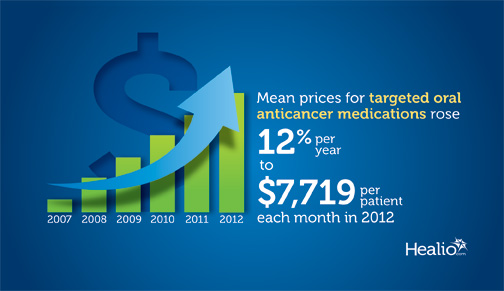Rising cancer drug costs counteract financial relief for Medicare recipients
Although the closure of the coverage gap in Medicare Part D offered financial relief to patients with cancer, the rising costs of targeted oral anticancer medications may threaten that relief, study data showed.
“The low [out of pocket] costs of targeted oral anticancer medications observed among privately insured patients with cancer are largely attributable to patient cost sharing taking the form of coinsurance with an out-of-pocket max or copayments in the majority of pharmacy benefits for these patients,” Ya-Chen Tina Shih, PhD, professor of health services research and chief of the section of cancer economics and policy at The University of Texas MD Anderson Cancer Center, and colleagues wrote.
Shih and colleagues noted that patients enrolled in Medicare Part D “spend their way sequentially” through four phases: a deductible with 100% cost sharing, initial coverage of up to $2,960 in drug costs with up to 33% coinsurance on specialty drugs, the coverage gap with 100% coinsurance and catastrophic coverage, which includes 5% cost sharing and has no out-of-pocket maximum.
“Understanding the financial burden for Part D enrollees is important because they are more likely than other Medicare beneficiaries to be members of vulnerable groups: older, in fair or poor health, racial and ethnic minorities, or with low income and educational status,” Shih and colleagues wrote.
The researchers used the SEER database to identify 42,111 patients enrolled in Medicare Part D who received targeted oral anticancer medications between 2007 and 2012. Shih and colleagues calculated out-of-pocket payments and drug costs per patient per month, and compared the coverage gap with rising treatment costs.
Shih and colleagues reported that mean prices for targeted oral anticancer medications rose 12% per year to $7,719 per patient each month in 2012, compared with just 3% for the general prescription drug consumer price index. Each year, mean patient out-of-pocket payments fell by 4%. In 2011, those with high financial burdens saw a 40% drop as the coverage gap began to close under the Affordable Care Act.
“Although our findings provide support for patient financial improvements under this policy change, it is important to note that the financial burden for patients enrolled in Medicare Part D who take targeted oral anticancer medications remains substantially higher than for those with private insurance,” the researchers wrote. “The patterns we documented in Medicare drug price inflation are mirrored in studies using commercial insurance claims. It is possible that sustained price increases for targeted oral anticancer medications could outweigh the savings patients are expected to achieve through the coverage gap closure, eventually causing out-of-pocket payments to grow again.” – by Andy Polhamus
Disclosure: Shih reports research funding from Novartis. Please see the full study for a list of all other researchers’ relevant financial disclosures.

